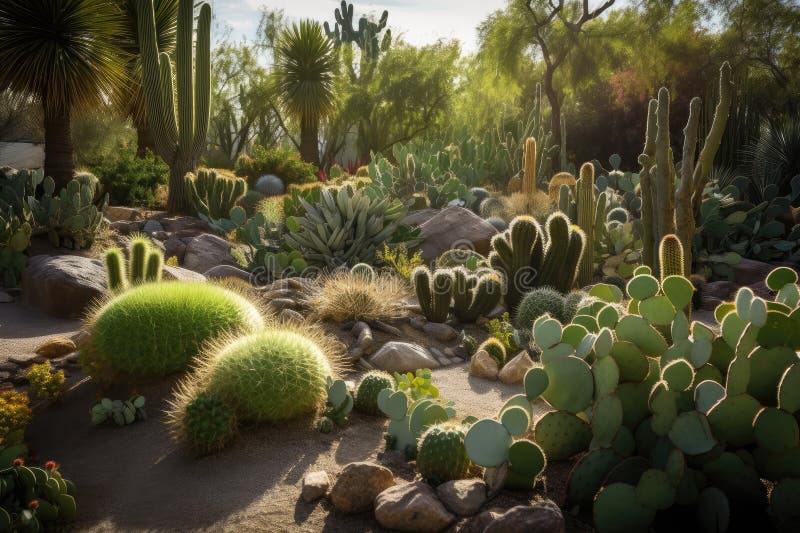Amidst the arid landscapes of deserts around the world, cacti have garnered attention not only for their resilience but also for their unique and mesmerizing forms. Yet, they are not the only plant group that flourishes in such environments. This article delves into the realm of plants that share a habitat and aesthetic allure with cacti, highlighting succulents and other drought-resistant flora.
Through the lens of their adaptations and visual appeal, we will explore the complex relationships between these plants, unveiling their intrinsic beauty and survival strategies.
What are Succulents? The Verdant Companions of Cacti
Although cacti are perhaps the most famous desert-dwelling plants, succulents are their close relatives, forming a broad group characterized by their ability to store water in their leaves, stems, or roots. This adaptation is not merely advantageous; it is essential for survival in water-scarce environments. The thick, fleshy structures of succulents allow them to endure prolonged periods of drought, making them well-suited for the challenges of desert life.
From the jovial Echeveria to the striking Aloe Vera, succulents exhibit a stunning variability in shape and texture. Their architectural forms can be both minimalist and elaborate, each presenting a different perspective on the fragility of beauty in harsh climates. For instance, the rosette form of the Echeveria can evoke images of a blooming flower in a desert, offering an ethereal contrast to the sandy backdrop.
Coloration adds another layer to their aesthetic appeal. Some succulents flaunt vivid colors, transitioning from jade green to deep burgundy depending on light exposure and environmental conditions. The rich pigmentation can serve as a protective mechanism against UV radiation, showcasing nature’s clever adaptations.
The Irresistible Allure of Agave Species
Among the diverse array of succulent plants, Agave species stand out not only for their distinctive physical forms but also for their unique reproductive strategies. Manifesting as spiky rosettes, these plants engage in dramatic life cycles characterized by a phenomenon known as monocarpic flowering. This means the plant blooms only once in its lifetime, producing a majestic flower stalk that can tower many feet above the plant itself.
This striking visual spectacle, akin to a natural fireworks display, captivates observers, as the towering stalk often blooms after a lengthy period of maturation that can span decades. Once it flowers, however, the parent plant typically dies, channeling its remaining energy into this final act of beauty—a poignant reminder of the ephemeral nature of life.
Agave’s aesthetic does not stop at its floral display; its sculptural quality makes it a favorite among landscape designers. When cultivated correctly, Agave can become a focal point in gardens, adding an intriguing contrast against softer greenery or even rocky terrain. The geometric symmetry of its spines and leaves offers a striking counterbalance to the wildly organic forms of other plants.
Mesembs: The Hidden Gems of the Desert
While cacti and popular succulents like Aloe and Echeveria dominate the landscape, there’s a lesser-known group that deserves attention: Mesembryanthemaceae, commonly known as mesembs. These delightful plants display a plethora of forms and colors, often adorned with unexpected flowers that can range from the subtle to the dazzling.
One of the most charming aspects of mesembs is their ability to thrive in the most inhospitable conditions, often found nested in rocky crevices. Many of these plants display an engaging dichotomy in their appearance—their thick, fleshy leaves may be reminiscent of elegant jewels shimmering under the sun, especially after a refreshing rain.
A standout species among mesembs is Lithops, also known as “living stones,” so named for their remarkable resemblance to the pebbles that surround them. This intriguing camouflage not only serves to deceive predators but also helps them conserve moisture. Their ability to blend seamlessly into their surroundings raises an intriguing question about adaptation and survival, shedding light on the harsh realities of life in the desert.
The Relationship Between Cacti and Their Desert Dwelling Kin
The interplay between cacti, succulents, and other desert plants is not merely one of aesthetic appeal; it represents an intricate web of ecological relationships. These plants might compete for resources, yet they also coexist symbiotically, sharing their adaptations to thrive in challenging environments. For instance, the root systems of certain cacti can extend far and wide, allowing them to access moisture from deep within the ground while simultaneously providing stability to the soil that benefits surrounding flora.
Furthermore, the adaptations seen in these plants facilitate a coexistence that highlights resilience, beauty, and the necessity of companionship in survival. Their coexistence symbolizes a broader ecological principle: the interdependence of life forms, where one’s survival can bolster another’s existence.
In conclusion, while cacti dominate the arid landscapes with their iconic forms and spiky defenses, they share their domain with a multitude of succulents and other desert plants that echo their resilience. The richness of their textures, colors, and growth patterns contributes to the allure of desert ecosystems. Together, these plants tell a story of survival replete with intrigue, beauty, and the splendor of life thriving amidst adversity.





Leave a Comment